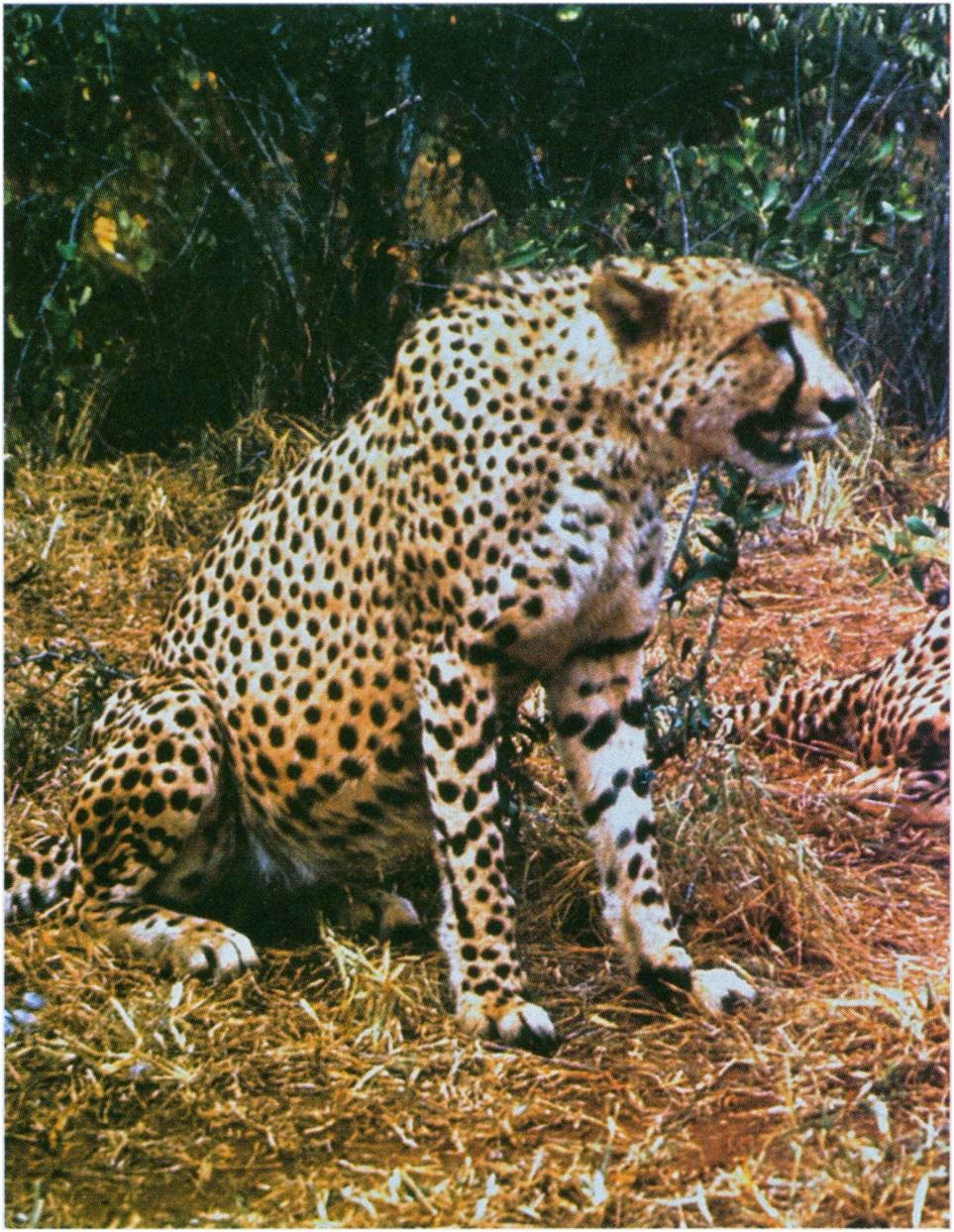The Acinonyx Genus: Cheetahs
The Acinonyx genus is undoubtedly the most unique felid alive today, instigating many heated debates on the subject of genetic variation and cladistic analysis. There was once 4 species that belonged to the Acinonyx genus, but now A. jubatus or the modern cheetah (see figure 1) is the only existent species left. Unlike most felids A. jubatus is principally crepuscular, distinct from nocturnal felids, and instead of using a short range ambush approach to hunting, cheetahs chase down their prey at high speeds (up to 103km/hr) over several hundred metres (Krausman & Morales 2005). Morphology and behaviour are related, thus to increase traction cheetahs have a diminished degree of retraction in the claws and possess longer forelimb bones for more cursorial movement, characteristics shared by canids but not other felids. Cheetah morphology is highly autapomorphic in the Felidae family, which makes it difficult to place them accurately within the Felidae family tree, and the similarities between cheetahs and canids is most likely due to convergence (Russell & Bryant 2001). Because cheetahs occupied the same area as many other cats it evolved to fill a new niche and use a different hunting strategy, becoming an animal that is morphologically stuck between a canid and a felid.
Figure 1. Photograph of adult A. jubatus (Krausman & Morales 2005).
Genetic studies on modern cheetahs as a species has also led to the discovery of their extreme lack of genetic variability (Krausman & Morales 2005). Genetic monomorphism of modern cheetahs was most likely due to a severe population bottleneck at the end of the last ice age when vertebrate extinction rates were high, leading to a period of inbreeding which still occurs today. This inbreeding of individuals has significantly reduced population numbers and has caused spermatozoal abnormalities and other genetic issues resulting in high juvenile mortality rates and susceptibility to disease (Wayne et.al. 1986). Therefore it is important to study the phylogenetics of species in order to acknowledge their vulnerability and fascinating peculiarities.
References:
- Krausman PR & Morales SM 2005, 'Acinonyx jubatus', Mammalian Species, no. 771, pp. 1-6.
- Russell AP & Bryant HN 2001, 'Claw retraction and protraction in the Carnivora: the cheetah (Acinonyx jubatus) as an atypical felid', Journal of Zoology, vol. 254, no. 1, pp. 67-76.
- Wayne RK, Modi WS & O'Brien SJ 1986, 'Morphological Variability and Asymmetry in the Cheetah (Acinonyx jubatus), a Genetically Uniform Species', Evolution, vol. 40, no. 1, pp. 78-85.




"but now A. jubatus or the modern cheetah (see figure 1) is the only existent species left"
ReplyDeleteThat's actually debatable. There are a number of people (myself included) who think the King Cheetah is sufficiently different from regular cheetahs to warrant being classified as a separate species- Acinonyx rex.
In any case though, this is an interesting post. Cheetahs are fascinating creatures.
Yes for a while the King cheetah was thought to be a subspecies of Acinonyx but the only difference between a King cheetah and a typical cheetah is fur colour. There is no other morphological difference. And genetically, it was discovered that the unusual fur pattern was only due to a single recessive gene. Just like blue eyes in some people are the result of a single recessive gene. But of course, you may have your own opinion on the matter.
Delete"the only difference between a King cheetah and a typical cheetah is fur colour"
DeleteThere are actually some other differences too. King cheetah hairs have a different cuticular scale pattern than that of normal cheetahs. And the behaviour of the two is somewhat different, with the normal cheetah being more of a diurnal savannah dweller and the king cheetah more of a nocturnal forest dweller.
That said, if the king cheetah really is just an unusual variant of Acinonyx jubatus there is still another interesting possibility- that we are actually seeing evolution in action. That is, that while not a separate species now the king cheetah may well become a separate species in the future if it remains reproductively separated from the normal cheetah long enough.
This comment has been removed by the author.
ReplyDeleteThank you for the interesting debate on the King Cheetah You mention genetic bottlenecking, of which this species is somewhat iconic. However, at the end of the last ice age it could be predicted that other felids would experience the same pressure, so why don’t we see such a high incidence in other species?
ReplyDeleteWell actually, the last ice age ended around 12,000 years ago which is when the cheetahs experienced the bottleneck and it is also when the sabre-toothed cats and other large carnivores in North America begin to disappear. So many felids did not survive the end of the last ice age, while cheetahs experienced a severe bottleneck but they were able to survive. This is what I think happened based on what I have read.
Delete